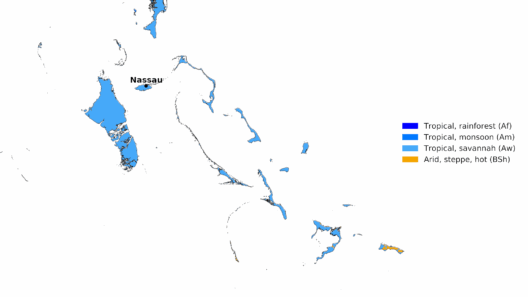Temperate deciduous forests are a unique ecological niche characterized by distinct seasonal variations, which contribute profoundly to their climate and the intricate web of life that thrives within them. These forests are predominantly located in the eastern United States, parts of Europe, and East Asia. The climate in a temperate deciduous forest is a tapestry woven from the threads of warm summers, cold winters, and the gentle transitions of spring and autumn. Observing the rhythm of the seasons in these forests is a reminder of nature’s magic, inviting deeper contemplation about the interconnectivity of ecosystems.
The defining feature of the climate in temperate deciduous forests is its four distinct seasons. The summers are typically warm, with average temperatures ranging from 70°F to 85°F (21°C to 29°C). Higher humidity levels during this season contribute to lush canopies, vibrant foliage, and prolific animal activity. The warm weather lures a plethora of organisms out of their dormant states, from insects to mammals, all vying for resources.
As summer fades, a gradual transition into autumn ensues. During this period, the phenomenon of leaf fall becomes a captivating spectacle. Trees like oak, maple, and birch unveil a breathtaking array of colors, transforming the forest into an artist’s palette of yellows, oranges, and reds. This vibrant display isn’t merely for aesthetic pleasure; it serves ecological purposes. The process of leaves changing color is influenced by environmental factors such as temperature and daylight hours. In response to these changes, chlorophyll breaks down, and other pigments emerge, providing insights into the health of the forest ecosystem.
As autumn progresses, temperatures begin to dip, heralding the approach of winter. This season can be harsh, with temperatures dropping significantly, sometimes plummeting below 32°F (0°C). Snowfall may blanket the forest, creating a serene yet stark landscape. Many species resort to hibernation or migration during these frigid months, showcasing nature’s resilience and adaptability. The forest, seemingly silent and still, harbors life that is more dormant than absent. Interestingly, this period of cold is essential for many tree species, as a winter chill allows for the process of stratification—an important step for seed germination in the following spring.
With the arrival of spring, life awakens once again, making for yet another seasonal transformation. Temperatures gradually rise, ranging from 40°F to 70°F (4°C to 21°C), and the forest floor bursts with new growth. In this rejuvenating season, flowering trees such as dogwoods and redbuds provide nectar for pollinators like bees, crucial for the reproductive cycles of numerous plants. The combination of melting snow, increased rainfall, and warming sunlight catalyzes a vibrant resurgence of biodiversity. The interdependence of flora and fauna fosters a lively ecosystem, showcasing the delicate balance maintained within temperate deciduous forests.
The climate of temperate deciduous forests is also significantly influenced by geographical factors, including latitude and altitude. Regions closer to the equator tend to have milder temperatures, while higher altitudes can produce cooler microclimates. Proximity to large bodies of water can moderate temperature variations, resulting in milder conditions. This is evidenced in coastal regions of temperate deciduous forests, where oceanic influences contribute to more moderate climates that can support different types of species compared to their inland counterparts.
Moreover, precipitation plays a pivotal role in shaping this ecosystem. These forests typically receive between 30 to 60 inches (76 to 152 cm) of rainfall annually, evenly distributed throughout the year. Rainfall is especially critical as it dictates the availability of water for trees, underbrush, and wildlife. During the growing season, the availability of moisture is paramount for sustaining the various life forms that populate these regions. It is fascinating to note how even slight shifts in rainfall patterns—often attributed to climate change—can have cascading effects on the entire ecosystem, leading to consequences such as altered growth rates, changes in species distribution, and even shifts in animal behavior.
The implications of climate in temperate deciduous forests extend beyond mere temperature and precipitation. They resonate with the global climatic patterns influenced by climate change. Global warming and its associated phenomena, such as increased atmospheric carbon dioxide levels, have far-reaching impacts. These changes can lead to phenomena like earlier leaf budding, prolonged growing seasons, and shifts in plant and animal distributions. Such alterations pose significant threats to the intricate balance that these forests rely upon for stability. The continued investigation of how climate variability affects this ecosystem is crucial for devising effective conservation strategies.
Overall, the climate of temperate deciduous forests is a symphony of seasonal transitions, each bringing its own rhythm and vitality. The interactivity of temperature, precipitation, and geographic factors intricately weaves the narrative of life within these forests. This remarkable ecosystem serves not only as a refuge for countless organisms but also as a vital component of the Earth’s climate system. Appreciating the delicate balance of these regions urges a greater awareness of the challenges that arise from climate change, encouraging a collective responsibility to protect these irreplaceable environments.
In pondering the climate of temperate deciduous forests, one cannot help but marvel at the interconnectedness of life. The cyclical nature of the seasons, with their distinct beauty and challenges, teaches invaluable lessons about resilience, adaptation, and the vital importance of conservation. As stewards of the Earth, acknowledging and embracing this profound connection can inspire a deeper commitment to preserving the delicate balance that sustains life in these enchanting ecosystems.








